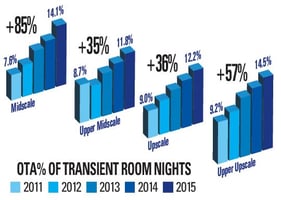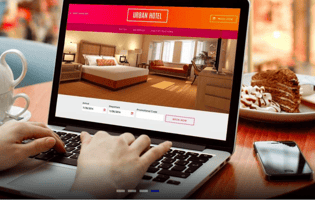The Commercial Strategy Playbook, An Imperative Driven by Digital Disruption
Blog
Revisiting Customer Acquisition Cost Management in Hospitality: Preparing for 2025
As the end of 2024 nears, and we wrap up planning for 2025, it’s crucial we don’t lose sight of one of the most important metrics in our industry: guest acquisition costs. While this isn't a new challenge, its importance has only grown over the years. This is a perfect time of year to reassess our strategies and ensure we're using the most effective approaches moving forward.
For years, we’ve grappled with managing acquisition costs, often relying on methods and data that, while once effective, are now showing their limitations:
- Individual Transaction Analysis: Examining costs on a per-transaction basis has long been a go-to strategy, but it's becoming increasingly inadequate in our complex distribution environment.
- P&L Line Item Focus: While still valuable for overall financial health, focusing solely on P&L line items provides a limited view of acquisition costs and their impact.
- OTA Commission Negotiations: Many hotels still wish they could negotiate their OTA commissions differently, but this addresses only a fraction of the overall acquisition cost picture.
These go-to approaches fall short in today's data-rich, fast-paced market. It's time to revisit and expand our strategies.
To truly optimize acquisition costs, we must continue to shift our focus from isolated transactions to a comprehensive view of our business mix. This isn't a new idea, but its implementation is more critical now than ever. The job of managing hotel operating costs has traditionally been the responsibility of the operational teams, but who is managing the rapidly rising costs to acquire and retain customers?
There is an emerging imperative for commercial teams to participate in cost management –-not costs in general—specifically, those costs related to customer acquisition and retention. This is core to the discipline of commercial strategy.
Many commercial leaders have long argued that they can’t be held accountable for a hotel’s profit since they are not responsible for labor cost (the biggest driver of hotel expense), or for other operating expenses.
While this is true, in the U.S. market overall, the cost of customer acquisition is now 15%-25% of guest paid revenue and rising which is second only to labor cost which is slightly more than 30% of revenue.
Leveraging Advanced Data and Technology
Good news for the future - we have better tools than ever before:
- Comprehensive Data Integration
We now have access to richer, more integrated datasets, including:
- Cross-channel and rate category booking patterns
- Detailed revenue metrics including what guests pay, what hotels collect, and what they keep (COPE Revenue)
- Granular cost breakdowns by channel and segment
- Advanced market demand forecasts
- Predictive Analytics and Machine Learning
The use of artificial intelligence and machine learning in our industry continues to evolve, enabling:
- More accurate demand forecasting by hotel, submarket, and market
- Precise identification of profitable guest segments
- Optimization of business mix and data to support strategic and tactical action plans
- Sophisticated Reporting and Visualization
Modern tools offer:
- Real-time, intuitive dashboards for quick trend identification
- Alerts for anomalies or opportunities to shorten time focused on outliers
- Customizable reports for different levels of management
Implementing an Optimal Business Mix Strategy
The start of a new calendar year is the perfect time to focus (or refocus) on intentionally targeting the most profitable business mix. The most efficient way to manage cost of acquisition is to plan and pursue a targeted mix of business that is known to be the most profitable.
Avoid guessing or hoping.
Intentionally go after specific business that is (1) known to exist in the market and (2) to be a fit for your hotel. You may not succeed at getting all that is included in the pre-determined and targeted “most profitable mix,” also known as “optimal business mix”, but you can evaluate what you achieved, AND what you did not, and continue to chip away at the full target over time.
- Performance evaluation metrics focus on profit contribution
- Identify most profitable business mix targets before funds or staff are deployed
Operations, revenue, sales and marketing team agree on targets and resource deployment, reducing silos during planning purposes - Tactical execution remains with specialized teams (i.e., business transient (BT) sales, group sales, digital, brand/field marketing, third party such as OTA or TMC/TA promotions, etc.)
- Tradeoffs are made and all segment/channel options are considered to find the business mix that contributes most to profit.
Leveraging Market Intelligence
In planning for 2025, it's crucial to utilize broader market intelligence. At Kalibri Labs, we've refined our approach to provide more actionable insights, including the release of our latest on-the-books (OTB) module, OTB Signals. This brings an innovative approach to forward-looking data to our industry.
OTB Signals has been established using submarket comparisons, rather than a select group of competitors. Supply changes over time with hotels continuously coming online, offline, and rebranding, it can be limiting to view just a select group of competitors trends. Submarkets are greater in scope and supply, which allows for a larger volume of forward-looking reservations to highlight indicators of shifts in demand. We believe larger submarket shifts from period-to-period are more actionable than granular nuances of shifts among smaller data sets and groupings of hotels, allowing you to be most effective in managing your strategy.
This approach ensures that hoteliers have access to robust, reliable data for making informed decisions about their acquisition strategies.
As we look ahead to our 2025 success, managing acquisition costs effectively remains a critical factor in hotel profitability. While the concepts aren't new, the sophistication of our approaches and tools continues to evolve. By revisiting and refining our strategies now, we can:
- Make better informed, real-time decisions
- Target our most profitable guest segments more effectively
- Optimize our business mix for maximum profitability
- Stay ahead of market trends and competitive pressures
The hospitality industry has always been about providing exceptional experiences for guests. By applying these refined approaches to acquisition cost management, we can ensure we're not just serving our guests well, but doing so in the most efficient and profitable manner possible, which benefits all of us. Sound good to you?
Let's chat more!




